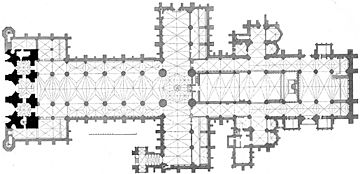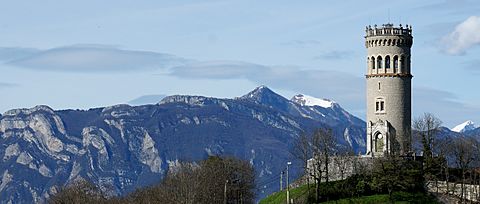Hugh of Lincoln facts for kids
Quick facts for kids SaintHugh of Lincoln O.Cart. |
|
|---|---|

St Hugh of Lincoln with his swan
Altarpiece showing the saint in the Carthusian habit from the Charterhouse of Saint-Honoré, Thuison, near Abbeville, France (c. 1490-1500) |
|
| Bishop of Lincoln | |
| Born | c. 1140 Avalon, Dauphiné, Holy Roman Empire |
| Died | 16 November 1200 (aged 59–60) London, England |
| Venerated in | Roman Catholic Church Anglican Communion |
| Canonized | 17 February 1220 by Pope Honorius III |
| Major shrine | St Mary's Cathedral Lincoln, England Parkminster Charterhouse West Sussex |
| Feast | 16 November (Catholic Church) 17 November (Church of England) |
| Attributes | a white swan |
| Patronage | sick children, sick people, shoemakers, swans and Roman Catholic Diocese of Nottingham |
Hugh of Lincoln (born around 1140 – died November 16, 1200) was a very important French church leader. He was a Benedictine and later a Carthusian monk. He became the Bishop of Lincoln in England.
Hugh is known as a saint in the Catholic and Anglican faiths. Catholics celebrate his feast day on November 16. Anglicans celebrate it on November 17. He is also called Hugh of Avalon.
Contents
Hugh's Early Life and Journey to Monkhood
Hugh was born in a place called Avalon, near the Dauphiné region. His father, Guillaume, was a soldier. When Hugh was eight, his mother Anne de Theys passed away.
His father then decided to become a monk. He took Hugh with him to the Augustinian monastery of Villard-Benoît. At 15, Hugh became a novice, learning about monastic life. By 19, he was ordained a deacon.
Around 1159, Hugh became the prior (a leader) of a nearby monastery. Later, he joined the Grande Chartreuse, a very strict Carthusian monastery. He became the procurator, managing the monastery's affairs.
Hugh's Role in England
In 1179, King Henry II of England asked Hugh to come to England. The king wanted Hugh to lead the Witham Charterhouse in Somerset. This was the first Carthusian monastery in England.
King Henry II had started this monastery as part of his apology for the murder of Thomas Becket. However, the building work was difficult. The first two leaders had not succeeded. Hugh was known for his strong faith and leadership.
Hugh found the monks living in simple log huts. There were no plans for a permanent building. He spoke with the king to get support and money. In 1182, King Henry gave a charter to officially establish the monastery.
Hugh made sure the monastery was built properly. He even made the king pay for any people who had to move for the building. Hugh led the monastery until 1186. Many people were drawn to the community because of him.
King Henry often visited the monastery. Hugh was not afraid to tell the king when he thought he was wrong. For example, he told Henry off for leaving church positions empty to keep the money for himself.
Becoming Bishop of Lincoln
In 1186, King Henry called a meeting to discuss church matters. One important topic was filling the empty bishop position in Lincoln. Hugh was chosen to be the new bishop.
Hugh insisted that the election be done privately by the church leaders in Lincoln. This showed his independence from the king. He was consecrated as Bishop of Lincoln on September 21, 1186.
Hugh quickly showed he was independent from the king. He even told off a royal forest official. He also refused to give a church position to one of the king's friends.
Hugh was a great bishop. He spent a lot of time in his diocese (the area he was responsible for). He was very generous with his charity. He also improved the quality of education at the cathedral school.
Hugh also tried to protect the Jewish people in Lincoln. They faced unfair treatment at the start of King Richard I's reign. Hugh stopped violence against them in several places.
Lincoln Cathedral had been damaged by an earthquake in 1185. Hugh started rebuilding and making it much larger. He used the new Gothic style. Sadly, he only saw the beginning of the choir section completed.
In 1194, he also expanded the St Mary Magdalen's Church in Oxford. Hugh and another bishop, Herbert of Salisbury, refused King Richard's demand for soldiers for his wars in France. As a result, the king took all their church income.
Hugh also served as a diplomat for the kings of England. He went to France for King Richard and later for King John in 1199. This trip made him very ill.
In 1200, he consecrated St Giles' Church, Oxford. A cross on the church tower is believed to remember this event. The St Giles' Fair was also started to celebrate this.
Hugh became sick during a meeting in London. He passed away two months later, on November 16, 1200. He was buried in Lincoln Cathedral.
Hugh was also responsible for building the first Bishop's Palace at Buckden. This palace was halfway between Lincoln and London. Later, stronger parts were added, including a tall brick tower.
Honoring Saint Hugh
Hugh was made a saint by Pope Honorius III on February 17, 1220. He is the patron saint of sick children, sick people, shoemakers, and swans.
His life story, called a Vita, was written by his chaplain, Adam of Eynsham. This book is still kept in the Bodleian Library in Oxford.
St Hugh's College, Oxford is named after him. A statue of Saint Hugh stands there. It shows him holding a model of Lincoln Cathedral. His hand rests on the head of a swan.
In Avalon, France, where he was born, a round tower was built in 1895. This tower honors Hugh on the site of his birthplace.
Hugh's Special Swan
Hugh's main symbol is a white swan. This comes from a story about a swan at Stow, Lincolnshire. This swan became very good friends with Hugh.
The swan would follow Hugh everywhere. It even guarded him while he slept. It was his constant companion in Lincoln. Hugh loved all the animals in the monastery gardens. The wild swan would eat from his hand. But it would attack anyone else who came near Hugh.
Hugh's Legacy Today
Many places are named after Saint Hugh of Lincoln. Buckden Towers and a Catholic church in St Neots are managed by the Claretians. In Lincoln, there is the St Hugh's Church.
There are also many churches dedicated to him across England. For example, the Church of St Hugh of Lincoln in Letchworth.
In the United States, several churches are named after him. These include churches in Illinois, Washington, New York, Wisconsin, and Florida.
In 2018, Saint Hugh was featured in a BBC Radio 4 drama. It was called The Man who bit Mary Magdalene. It showed the bishop searching for relics to help build Lincoln Cathedral.



